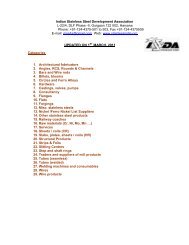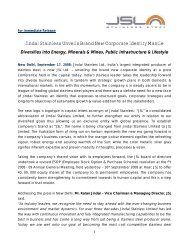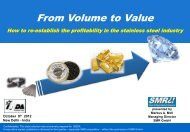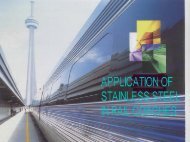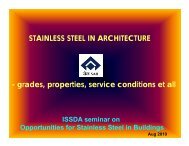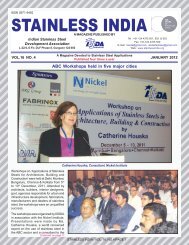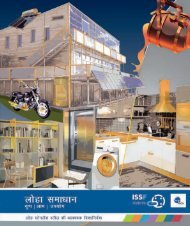The Ferritic Solution - Euro Inox
The Ferritic Solution - Euro Inox
The Ferritic Solution - Euro Inox
Create successful ePaper yourself
Turn your PDF publications into a flip-book with our unique Google optimized e-Paper software.
Summary“THE FERRITIC SOLUTION”By Jean-Yves Gilet, Chairman of the ISSF Market Development Committee (MDC)ISSF first discussed a project to promote ferritic grades inFebruary 2004, many members having pointed out that nojoint industry effort was being made in this direction.Under the guidance of the Market DevelopmentCommittee, an international group of experts, led by PhilippeRichard, started by gathering market statistics on ferriticgrades and applications. <strong>The</strong>y received contributions fromall around the world – especially Japan, where the ferriticsmarket is the most developed.<strong>The</strong> ICDA soon proposed to join the initiative and cofundthe project. This we accepted with great pleasure, asa concrete example of cooperation between internationalbusiness organisations.During the project’s start-up phase, nickel prices hitthe roof and interest in more price-stable grades increaseddramatically. ISSF then gave the project highest priority!I am now proud to present the results, which will ‘hit themarket’ at just the right time.I strongly believe that ferritic stainless steels can andshould be much more widely used. <strong>The</strong> purpose of thispublication is to bring about more extensive use of thesegrades.Stainless steels are ‘stainless’ because their chromiumcontent gives them remarkable resistance to corrosion.<strong>Ferritic</strong> grades, containing only chromium and possiblyother elements (Mo, Ti, Nb, etc.), are no exception. Wellknownstandard ferritic grades 409, 410 and 430 are readilyavailable all over the world. Very successfully used inimportant applications, such as washing-machine drumsand exhaust systems, they actually have much broaderapplication potential, in numerous fields.More recently-developed ferritic grades, such as 439and 441 meet an even broader range of requirements. <strong>The</strong>ycan be formed to more complex shapes and joined usingmost conventional joining methods, including welding.Thanks to the addition of molybdenum, the resistance offerritic grade 444 to localised corrosion is at least equal tothat of austenitic grade 316.Since ferritic grades do not contain nickel, their cost islower and more stable than that of austenitic stainlesssteels. <strong>The</strong>y can therefore:• complement type 304 within the stainless steel family(although 304 remains a versatile and commonly usedgrade);• be an alternative to the 200 series (offering generallybetter usage properties);• substitute for other materials in many areas (e.g. carbonsteel, Cu, Zn, Al, plastic, etc.), thanks to their specialtechnical properties – the drivers for replacement being,usually, technical and Life Cycle Cost benefits.<strong>Ferritic</strong> stainless steels’ magnetism is not a ‘negative’quality, somehow associating it with ordinary carbon steel.On the contrary, magnetism is a special asset of theseexcellent stainless steels, marking them out from otherstainless steel grades.To get the best results from ferritics, it is essential that:• new users be trained in forming and joining techniques;• the user consult his stainless steel producer regardingcorrect grade selection;• the user acquire his material from a reliable source,able to offer proven guarantees as to the grade, qualityand origin of the material supplied.<strong>The</strong> high quality of the team’s efforts and the strong supportof the ICDA allow us today to present a reference documentfor our stainless steel business. It benefits from highlyinteresting testimonials from customers, showing a livelyinterest in new developments. ISSF is grateful for all thesecontributions.Jean-Yves GiletChairmanMarket Development CommitteeISSF




